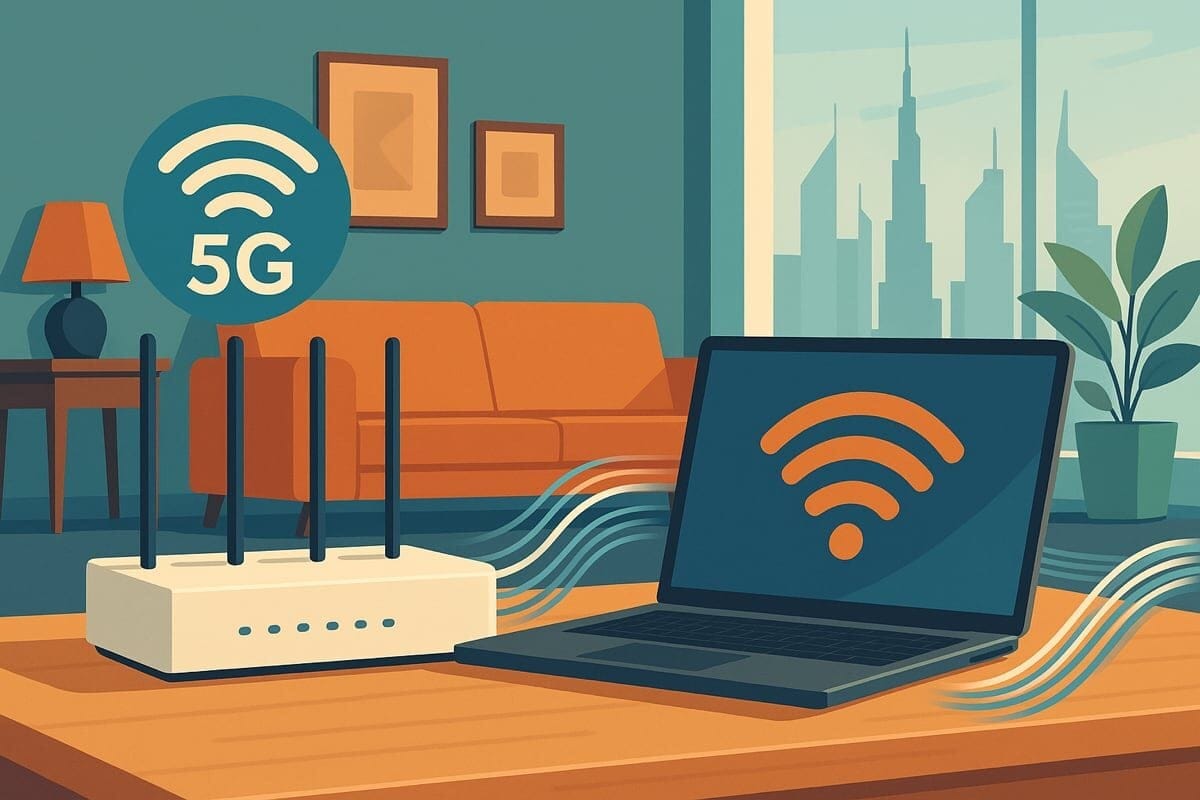Median fixed speeds in the region have jumped since 2024. The UAE now sits above 300 Mbps, Bahrain above 130 Mbps and Saudi Arabia above 120 Mbps. Credit goes to regulators and ISPs for lifting entry tiers, expanding fibre and pushing gigabit plans.
But the last metre in the home is still a mess. Many users remain stuck on Wi‑Fi 4 and 5, which drags real‑world performance far below what fibre can deliver. Ookla's latest report breaks down the numbers and what operators are doing to fix in‑home bottlenecks.
Fixed broadband got faster across the GCC
Entry plans went up. Multi‑gigabit arrived. Median speeds followed.
- UAE raised the base speed from 250 to 500 Mbps. Median downloads reached 317.98 Mbps in Q2 2025, with uploads at 147.28 Mbps. e& and du now sell 5 Gbps and even 10 Gbps in select areas. For current plan comparisons and pricing, see our guide to the best home internet packages in the UAE.
- Bahrain doubled entry speeds in 2023 and lifted the floor again to 300 Mbps in March 2025. Median downloads jumped from 86.61 Mbps (Q4 2024) to 130.74 Mbps (Q2 2025).
- Qatar made 1 Gbps the new normal in 2023 and was first in the Gulf with 10 Gbps consumer plans. Median speeds more than doubled over two years to Q2 2025.
- Saudi Arabia lifted minimums to 300 Mbps on leading lines and broadened gigabit offers. Median downloads reached 124.89 Mbps in Q2 2025.
Speed floors shape expectations. When the entry tier doubles, households upgrade devices and habits. Video, cloud backup and gaming feel smoother, and ISPs get room to upsell to multi‑gigabit. Kuwait and Oman, with lower fibre penetration, remain behind the leaders.
Wi‑Fi is the bottleneck most homes ignore
Ethernet tests are 2–3x faster than Wi‑Fi on the same fibre line.
- Across the four markets, Ethernet delivered up to 790 Mbps median downloads in the UAE, 654 Mbps in Qatar and 292 Mbps in Bahrain in Q2 2025.
- Uploads over Ethernet were more than twice Wi‑Fi in many cases, hitting 348.6 Mbps.
- Legacy Wi‑Fi dominates. In H1 2025, over two‑thirds of samples still used Wi‑Fi 4 or 5, with Bahrain highest at 81% and Qatar lowest at 61%.
- Wi‑Fi 6 brought 10x gains over Wi‑Fi 4 in Qatar and the UAE. Qatar saw a 12x uplift to 448 Mbps median downloads.
If your router is old or misconfigured, your shiny gigabit line looks very average. Many CPEs shipped since 2020 can run Wi‑Fi 5 or 6, yet homes still default to Wi‑Fi 4 modes. Common culprits: single‑SSID setups that push devices onto 2.4 GHz, disabled band steering and firmware left untouched. If gaming latency is your priority, our head‑to‑head on e& vs du for mobile gaming shows how network choices affect real‑time play, even on modern Wi‑Fi.
Why Wi‑Fi 6/7 and the right band selection matter
Devices camped on 2.4 GHz leave performance on the table.
- Wi‑Fi 6 (802.11ax) supports higher throughput and lower latency than Wi‑Fi 4/5. Wi‑Fi 7 adds wider channels and multi‑link operation across 2.4/5/6 GHz.
- The 5 GHz band consistently posts higher speeds than 2.4 GHz. The top 10% of 5 GHz samples reached multi‑gigabit rates in the UAE and Qatar.
- Wi‑Fi 7 is still tiny in share: 0.19% of samples region‑wide in H1 2025. The UAE led at 0.41%.
Two practical steps help right away: split SSIDs or enable proper band steering so close devices use 5 GHz, and upgrade to Wi‑Fi 6 routers with decent backhaul. If you’re planning a new mesh, here’s what’s next‑gen: our first look at a compact Wi‑Fi 7 mesh router and what to expect from early kits.
What ISPs are doing to fix the last‑metre problem
CPE upgrades, mesh bundles and FTTR are rolling out.
- New installs increasingly ship with Wi‑Fi 6 CPEs. Some gigabit bundles now include Wi‑Fi 7.
- Mesh nodes are discounted or included on higher‑tier plans to improve whole‑home coverage.
- Fibre‑to‑the‑room (FTTR) is arriving across Qatar, Saudi Arabia and the UAE. It extends fibre deeper into the home with thin, often transparent cabling.
- Gigabit prices are dropping. UAE 1 Gbps packages now start near USD 100 per month. Bahrain and Saudi Arabia have cut entry prices too.
FTTR is the big swing. It reduces the reliance on weak wireless backhaul and gets fibre closer to each device. Ooredoo Qatar bundles FTTR on top packages, while Salam, stc and e& in the Gulf are selling it as an add‑on. If you live in a multi‑storey villa, FTTR plus Wi‑Fi 6/7 mesh is the surest way to get consistent gigabit per room. Planning a wider upgrade? Start with our smart home networking guide to balance coverage, latency and device load.
What you should do at home today
A short checklist that actually moves the needle.
- Use Ethernet for desktops, consoles and TVs where possible.
- If your router is Wi‑Fi 4/5, ask your ISP for a Wi‑Fi 6 or Wi‑Fi 7 CPE upgrade.
- Enable band steering or split SSIDs to keep nearby devices on 5 GHz.
- Place mesh nodes on wired backhaul if you can.
- Update router firmware. Reboot monthly.
- Test with a modern phone or laptop to avoid device bottlenecks.
It’s boring, but it works. Most “slow fibre” complaints begin and end with a tired router or poor placement. The fastest router won’t fix a concrete wall and a bad backhaul. If you care about ping, a wired link remains king. For wireless latency beyond the home, keep an eye on access upgrades like du’s 5G+ launch and early 5G‑Advanced deployments, which help phones and hotspots.
Why is my gigabit plan only showing 200–300 Mbps on Wi‑Fi?Your Wi‑Fi is the cap. Many devices connect on 2.4 GHz or to routers stuck in Wi‑Fi 4/5 modes. Upgrade to a Wi‑Fi 6 CPE, enable band steering and move close devices to 5 GHz. Test on Ethernet to confirm the line speed.
Do I need Wi‑Fi 7 right now?Not strictly. Wi‑Fi 6 with proper placement covers most homes well. Wi‑Fi 7 becomes useful for multi‑gigabit WANs or heavy local transfers. If you’re buying a premium laptop, phone or mesh in 2025, Wi‑Fi 7 adds headroom.
Is FTTR worth paying for?In large villas or thick‑walled apartments, yes. FTTR puts fibre near rooms that struggle with coverage and gives your mesh a clean wired backhaul. It’s overkill for small flats with clear lines of sight.
Subscribe to our newsletter to get the latest updates and news








Member discussion